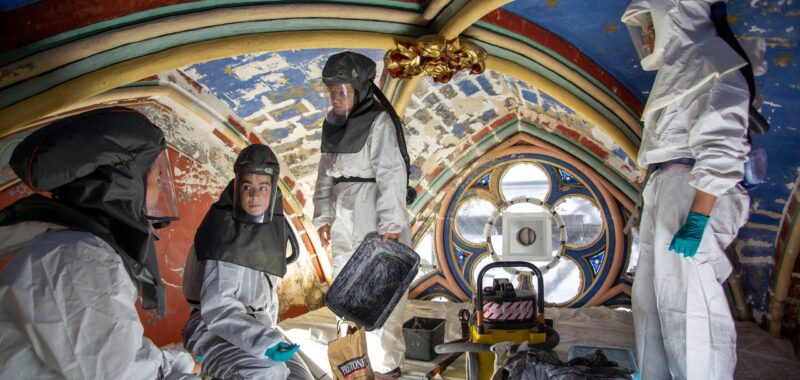Some time after six in the evening on April 15, 2019, Rémi Fromont was sitting at the Brasserie Saint-Malo, a lively café in Montparnasse, Paris, when his phone rang.
“Notre-Dame is on fire,” said a friend on the other end of the line.
Fromont, the chief architect of historic monuments at the French Ministry of Culture, assumed that the call was a joke. But when the caller insisted that he was dead serious, Fromont leapt out of his chair, got on his bike, and pedaled north toward the cathedral.
Fromont is a slim, elegant man of 46 with a cherubic face framed by tight brown curls. Born in Vincennes, outside Paris, he had spent his career renovating sites of national importance, and was intimately familiar with the medieval structure. Notre-Dame was a tinderbox, and if the fire couldn’t be controlled, he knew the result would be calamitous.
Fifteen minutes later, Fromont arrived at Notre-Dame de Paris, on the Île de la Cité. Wisps of smoke were rising from the cathedral’s lead roof covering. An ominous glow was beginning to envelop the Flèche, the over 300-foot-tall spire added by the French architect Eugène Viollet-le-Duc in 1859. But beneath the spire lay a greater risk: the cathedral’s medieval roof frame, a roughly 300-foot-long, 30-foot-high assemblage of medieval axe-hewn oak beams so dense and intricate that it had been nicknamed la forêt—the forest.
A colleague who had arrived a few minutes earlier approached Fromont. He, too, knew about ancient wood’s combustibility.
“The forest,” the colleague said, “is dead.”
Hundreds of firefighters were already trying to control the blaze. One expressed to Fromont his fear that the vaults, the limestone arches that formed the ceiling of the grand interior, might collapse. If that were to happen, the entire cathedral could come down. Fromont knew that Gothic cathedrals across France had withstood intense bombings during the two World Wars. “Everything [inside] was destroyed, but the high walls were still there,” Fromont explained. Then he shared his own concern: the two bells in the south tower on the western façade. If the fire spread there, the bronze bells inside—which weighed about 30,000 pounds—could crash to the ground, possibly damaging the walls and endangering the firefighters inside the church.
About an hour after his arrival, Fromont, with thousands of Parisians at the scene and millions watching around the world, looked on as the 750-ton spire, made of 1,230 oak beams, blazed, teetered, snapped like a matchstick, and crashed through the roof. Spectators broke into tears of disbelief and horror.
Soon, the forest succumbed to the fire. Flames raced through the lattice, turning the 800-year-old oak beams to ash. Joists and rafters crackled, combusted, broke apart, and tumbled onto the vaults, although, mercifully, most proved strong enough to withstand the weight of the falling wood.
Within a few hours, said Fromont: “There was nothing left.”
Fromont remained at the scene until 2 a.m., distraught, still not quite believing what he’d witnessed. For many the cathedral was the very soul of France, eternally bound up in the country’s identity. Victor Hugo had used it for the setting of The Hunchback of Notre-Dame. Napoleon Bonaparte rescued it from potential destruction during the French Revolution, and had himself crowned emperor there in 1804. Charles de Gaulle held a service in the cathedral after the liberation of Paris in 1944. By 2019, Notre-Dame drew more than 10 million visitors a year, making it one of the most popular tourist attractions in the world. Now it was a charred ruin.

